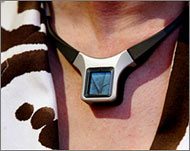Making a mobile statement in Asia
For Asia’s hip and swanky, carrying a mobile phone with a cracked screen and a tatty plastic cover is tantamount to a crime against fashion.

Instead, a Prada ensemble with Gucci loafers or Manolo Blahnik stilettos demands nothing less than a diamond-encrusted handset from China’s TCL Mobile Communication Co Ltd or an 18-carat white gold mobile with a sapphire crystal face by Nokia unit Vertu.
Indonesian haute couture designer Harry Darsono, 54, carries a $26,550, 215-gramme platinum Vertu cell phone to match his Lanvin shirts and Hugo Boss shoes when he entertains customers.
“I am very fussy. My hand phone, handbag and attire must be part of the overall art of presentation to the clients – you need to use their language so you can be close to them,” said Darsono, who was educated in France and collects vintage pianos and luxury cars.
While mobile makers are tight-lipped on revenues from their luxury segments, analysts say high-end sales could provide a lift as penetration rates level off and the take-up of high-speed data services remains lacklustre.
“Luxury and glamour models offer a different level of interest and engagement for consumers, which would spur them on to buy more new and beautiful phones,” said Ian Woodward, a consumer behaviour researcher at Australia’s Griffith University
|
Indonesian haute couture designer Harry Darsono, 54, carries a $26,550, 215-gramme platinum Vertu cellphone to match his Lanvin shirts and Hugo Boss shoes when he entertains customers |
London-based Vertu and Finnish parent Nokia, the world’s top handset maker, began developing the luxury models as early as 1997, Vertu President Nigel Litchfield said.
“As the industry became increasingly saturated in the last few years, manufacturers were compelled to discover new markets and identify upcoming trends in mobile phone consumption.”
At the end of 2003, Asia accounted for a third of Vertu’s total business, Litchfield said, adding that Hong Kong was its largest single market.
Fashion phones
Shiv Putcha, senior analyst with The Yankee Group, believes fashion phones could invigorate sales for handset makers, as slow data download speeds, poor content and handset glitches leave users disappointed with 2.5G and third-generation (3G) networks.
“Most of the models in the market do not address the consumer’s need for increased personalisation, and I believe this to be a significant driver of growth,” he said.
Given Asia’s high cell phone replacement rate – every nine to 18 months compared with about two years for Europe and the
United States – the region is the logical market to launch iconic handsets, Putcha said.
 |
|
The line between communication |
Motorola Inc, the world’s second-largest cellphone maker, said its line of fashion phones enjoyed triple-digit growth rates in the first quarter of 2004 over the final three months of 2003 in Southeast Asia, Australia, New Zealand, India, Bangladesh and Pakistan.
“In Asia, phones are much more of an aspirational statement about who you are and who you want to be,” said Scott Durchslag, a Motorola corporate vice president.
Motorola recently launched a clamshell V600 model that offers interchangeable covers studded with clear Swarovski crystals, and Nokia’s new 7200 model offers fabric covers that have analysts calling it the Louis Vuitton phone.
Gem-encrusted handsets also became the rage in China, the world’s largest wireless market, after TCL Mobile made waves in 2000 with the launch of its diamond-studded mobile phones.
Its limited edition range with genuine gemstones costs up to $2400.
Lucky charms
TCL Mobile, which is seeking a separate listing in Hong Kong and is 40.8%-owned by TCL International Ltd, controls about one-tenth of China’s cellphone market.
“Attaching jewellery on the phone adds a cultural and spiritual dimension to the product,” said TCL Mobile’s managing director, Wan Ming Jian.
|
“To many Chinese, precious stones symbolise esteem, good fortune, peace and love. So, jewelled mobile phones are not just communication tools, they also act as lucky charms” Wan Ming Jian, |
“To many Chinese, precious stones symbolise esteem, good fortune, peace and love. So, jewelled mobile phones are not just communication tools, they also act as lucky charms,” he said.
TCL Mobile sold more than 12 million jewelled phones – most of which had fake gems – between 2001 and the first six months of 2003.
Analysts said handset makers in China – numbering between 30 and 50 – needed to differentiate their products to survive in one of the world’s most fragmented and competitive markets.
“Growth in China’s mobile phone sales has been slowing – from 50% in 2002 to 30% last year, and a forecast 10 to 15% in 2004,” said an analyst with BOCI Securities Ltd in Hong Kong.
“You need to stimulate your customers to buy new phones by adding new features. You have to distinguish yourself from the competition to protect your market share,” he said.